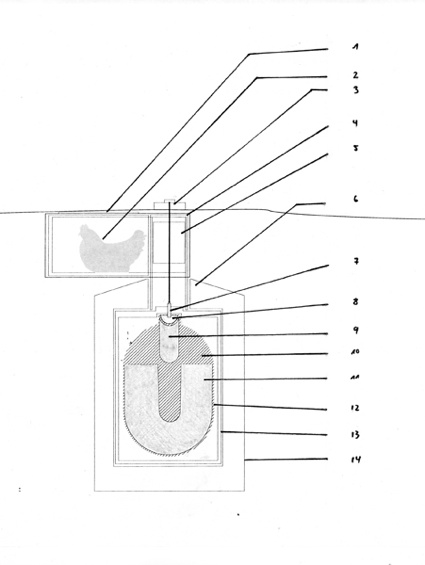 Technical drawing of nuclear landmine including chicken box. Image Marcel Helmer
Technical drawing of nuclear landmine including chicken box. Image Marcel Helmer
Last week was the School of Design students work in progress exhibition at the Royal College of Art, that’s probably my favourite show at RCA because everything is still gloriously wild, promising and unpolished.
Marcel Helmer from Design Interactions had a very puzzling display showing sketches of an audio recorder inside of a walnut that squirrels would then bury in enemy territory, nuclear landmine warmed up by live chickens, military equipment for insect related units, etc.
He called these scenarios Technocratic Fables. They tell the tales of machines depending on, cooperating with or being defeated by animals. The work looked closely at animals in military use. Some of his examples came from the past (believe it or not, in the 1950s the UK seriously planned to put chicken inside landmines to regulate its temperature), present and looked at how engineered animals might shape the future of warfare.
These fables show potential of putative simple organisms in the past, present and future. What if invasive species become a weapon? What if the next danger is an engineered physical insect, not a digital one?
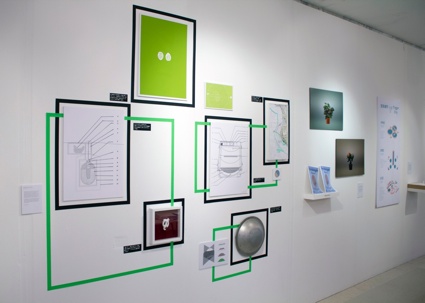 View of the project at the WIP show. Photo by Marcel Helmer
View of the project at the WIP show. Photo by Marcel Helmer
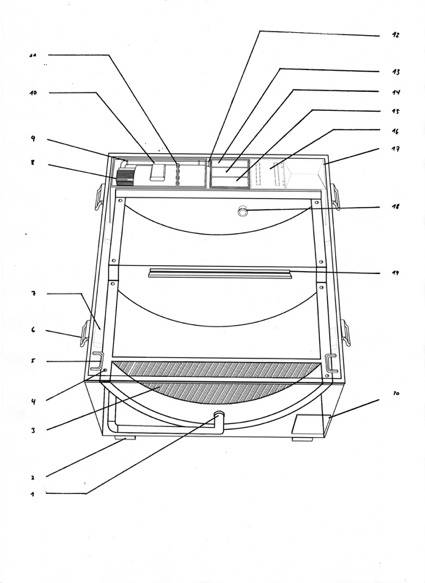 Mechanical drawing of jelly fish breeding tank. Image Marcel Helmer
Mechanical drawing of jelly fish breeding tank. Image Marcel Helmer
The designer kindly accepted to answer my questions:
Hi Marcel! Why did you decide to present the work as ‘fables’ and not as just ‘projects’ like most other works in the show?
Technocratic fables are a collection of stories. All of them based on animal/technology interaction inside the field of military purposes. They are placed between the 1930 and the not too distant future, embedding the most sophisticated technology of each specific time into the tale. Showing its vulnerability, dependency or cooperation to/on/with animal behaviour.
Traditional fables use anthropomorphised animals not only to tell fantastic and entertaining stories, but to teach and exemplify sociological human behaviour. My idea is to use animals and technology not to explore the human/human interaction, but the human/technology side of society of a specific time. Specific time for the reason, because of the idea that a relationship of course changes throughout history, whether it actually does may remain unanswered though. It is certainly not about finding new uses for animals in warfare, even though it mentions the possibility of invasive species used as weaponry.
Can you walk us through some of those animals used for military purposes?
My favourite story so far: During the cold war Germany was separated into the soviet east and the allied forces’ west. The western forces were seriously concerned about the possibility of the soviet army conquering western Europe, therefore they developed a plan B. Burying nuclear landmines to make central Europe inhabitable in case of an invasion. The only problem they had, German winters can be quite rough, and the electronics of the time weren’t made for those temperatures. The proposed solution: burying live chicken with the bombs to use their body heat to keep the sensitive electronics alive. The soviet reaction to this plan was the attempt to train foxes, not only to track down the bombs but to “defuse” them by killing the chicken.
This is one example of the past, more recent ones include squirrels captured by the iranian government because they were “carrying espionage equipment”, jellyfish fields blocking passage ways for multi million dollar nuclear submarines or moths distracting sonar controlled homing missiles.
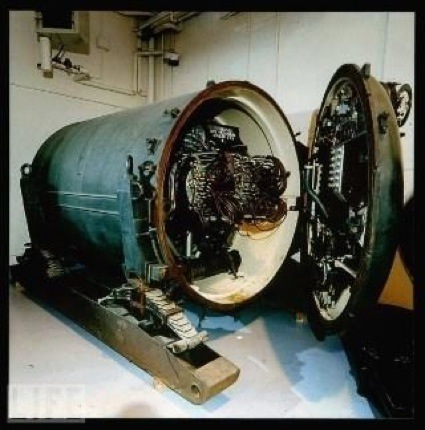 The mine would be kept warm by chickens
The mine would be kept warm by chickens
Why did you associate a particular animal with a particular military use? Are they already used for similar purposes?
This is the twist: the stories i just mentioned are true! Design fictions like to use fantastic narratives to communicate scenarios, encasing and presenting them as realistic as possible, perfect renderings, tables and facts to create plausibility. I’d like to go the other way around, i cloak the stories as fictions to surprise with the truth, stressing once more that reality can be stranger than fiction! My design is the communication of the story and the speculative next step of these truths, what if this really happened and became the standard of warfare? What are countermeasures to chicken bombs? What does a squirrel use to spy on you? How can jellyfish become a weapon? It is an alternative century of animals in warfare.
Are animals still used in warfare?
Absolutely. But today its usually less spectacular and experimental, since computer technology supposedly became the answer for most problems. It is no more necessary to use pidgeon as pilots for “intelligent” missiles (again, true story!). We still cherish the advanced sense of smell of dogs, or recently even rats to find hidden landmines. One of the more fantastic approached is the research of the U.S. navy using dolphins to find sea mines. On the other side, who knows what’s happening behind closed curtains? The “chicken bomb” was a rumor, until it has been proven in the early 90s by secret documents, which became open to the public after the fall of the Soviet Republic. It definitely leaves enough space for speculations of future stories, especially in regard to engineered organisms, which will be part of the “near future story” i develop.
These factors are also part of the reason why i choose to place it in the realm of military technology. It’s the secret, yet fantastic nature that evolves out of the almost blind trust into technology inhabited by this area. Pushing the boundaries of technology with only limited emphasis on ethical or moral restrictions.
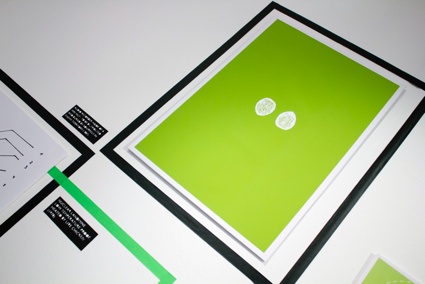 View of the project at the WIP show. Photo by Marcel Helmer
View of the project at the WIP show. Photo by Marcel Helmer
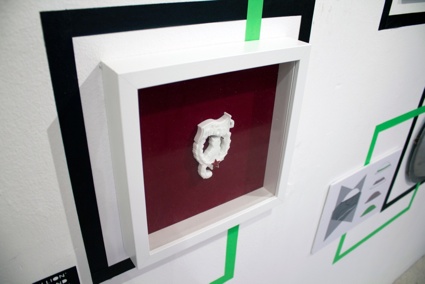 Emblem of the soviet “fox bataillon”, founded to track down and defuse allied “chicken bombs” (1971) View of the project at the WIP show. Photo by Marcel Helmer
Emblem of the soviet “fox bataillon”, founded to track down and defuse allied “chicken bombs” (1971) View of the project at the WIP show. Photo by Marcel Helmer
Are you planning to push the project further?
Yes, it is definitely going to be one of my main projects i’ll be presenting in the Summer show. While i personally appreciate the idea of mixed media installations to offer the audience artefacts to explore the fables, i’d like to work closer to the expectations of classic fables in literature. Whether this is going to be a book, including the fables and the research or another traditional form of storytelling is still to be determined. I certainly have a lot more fantastic stories written not only by me, but history itself i can work with.
Thanks Marcel!
The Work in Progress show of the design school is over, alas! but the School of Architecture Work-in-Progress Show opens in a few days in the Kensington building.
